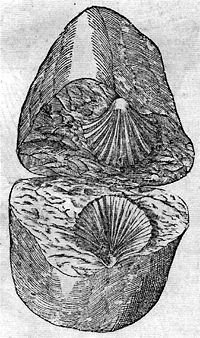An excellent account of this converging history of science and philosophy is given in Paolo Rossi’s The Dark Abyss of Time: The History of the Earth and the History of Nations from Hooke to Vico (Chicago: Univ. of Chicago Press, 1984).
As architect Kengo Kuma notes, an “anti-object” is one that induces a reckoning with the external world through its inherent transgressability. See Kuma, Anti-object: The Dissolution and Disintegration of Architecture, trans. Hiroshi Watanabe (London: Architectural Association, 2008).
These “living pigments”—which subsist by cannibalizing former generations of the microbacteria—were identified in 2010 by a team of researchers led by Dr. Jack Pettigrew of the University of Queensland. See Pettigrew et al., “Living pigments in Australian Bradshaw rock art,” Antiquity, vol. 84, no. 326 (Dec. 2010).
See Jack Pettigrew, “Iconography in Bradshaw rock art: breaking the circularity,” Clinical and Experimental Optometry vol. 94, no. 5 (2011): 403–417.
The carbon imaginary is an analytic device advanced by Povinelli in approaching the impasses of theorizing biography (life descriptions) and geography (nonlife descriptions) within the conditions of Late Liberalism. It pinpoints broad-based political and subjective dependencies on metabolic imagery of birth, growth/reproduction, and death. This conceptualization will be addressed in the forthcoming Geontologies: A Requiem For Late Liberalism, the last in a three-volume enquiry into Late Liberal government and the potentialities of an “anthropology of the otherwise.” See also “Interview with Elizabeth Povinelli with Mat Coleman and Kathryn Yusoff,” Society and the Open Site, March 6, 2014.
In court challenges over the development of an AUD $40 billion gas-processing plant—the largest in the world—these caves and their icons must make testimony to their “value” in contestations with protagonists such as “the environment,” Aboriginal Traditional Owners, the voracious claims of the market, and Australian settler society. See “Gas hub: Controversy in the Kimberley,” Australian Broadcasting Corporation, April 12, 2013 →.
Here, the ideas and generous dialogue of Mihnea Mircan, with regard to the exhibition and research project “Allegory of the Cave Painting,” have offered a wealth of concepts and approaches to the semiologic effects of these pigmented microbiological agents.
Alicia Chang, “Scientists detail impact of ‘Big One’ quake in California,” USA Today, May 22, 2008 →.
Surrealist intellectual and historian of science and of ritual Roger Callois ventured an exemplary foray into such a field of petro-poetics in his unsurpassable volume The Language of Stones, accompanied by his own extensive collection of stone and rock cross sections. In preparation for the forthcoming sequel to Medium Earth, The Otolith Group will visit the Callois stone library.
Kodwo Eshun details the earthquake sensitive as a self-formed epistemic barometer at the thresholds of geo-acoustic awareness. See Eshun, “Medium Earth: Seismic Sensitivity as Planetary Prediction,” in The Whole Earth: California and the Disappearance of the Outside (Berlin: HKW, 2013).
Fernand Braudel, On History (Chicago: Univ. of Chicago Press, 1982), 65–75.
Here we attempt a reading of landforms and their displaced circulation via Elizabeth A. Povinelli’s conception of the “embagination of space by the circulation of things,” as developed in her text “Routes/Worlds,” e-flux journal 27 (Sept. 2011) →.
Achille Mbembe, On the Postcolony (Berkeley: Univ. of California Press, 2001).
René Descartes, Le Monde (1633).
Gottfried Wilhelm von Leibniz, “The Many Changes in our globe after its initial creation,” chap. V in Protogaea, trans. and ed. Claudine Cohen and Andre Wakefield (Chicago: Chicago Univ. Press, 2008).
Pliny the Elder, The Natural History of Metals, Book XXXIII, chap. 1 (77–79 AD).
This site-specific mural was commissioned for A Special Arrow Was Shot In The Neck … (Curator’s Series #7), June 13–August 2, 2014. Curated by Landings (Natasha Ginwala and Vivian Ziherl) at the David Roberts Art Foundation, London.
In his landmark publication Time and The Other: How Anthropology Makes Its Object (New York: Columbia Univ. Press, 2002), Johannes Fabian critiqued the ethnographic past in which the coevalness of the field was transmuted to a past tense in a process of othering through the written account.
Pliny the Elder, ibid.
This essay was commissioned in conjunction with the exhibition and research project “Allegory of the Cave Painting,” curated by Mihnea Mircan, Extra City Kunsthal (Antwerp), September 19–December 17, 2014. It has additionally been prepared towards the forthcoming edition Landings: Witness Reports featuring Elizabeth A. Povinelli with the Karrabing Indigenous Corporation and other guests, presented in collaboration with Discipline Magazine, the Institute of Modern Art (Brisbane) and Gertrude Contemporary (Melbourne), December 2014. The authors would like to express their deep thanks to Mihnea Mircan, Elizabeth A. Povinelli, Kodwo Eshun, Anjalika Sagar, Anselm Franke, Prabhakar Pachpute, Rachel O’Reilly, Denise Ferreira da Silva, Filipa César, Angela Anderson, and Angela Melitopoulos for their sustained dialogue during the preparation of this essay.
